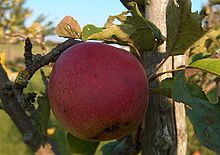Kharlamovsky
Charlamowsky is a variety of the apple ( Malus domestica ), which presumably has its origin in southern Russia or in historical Persia and was first planted in Hohenheim around 1830 . The variety is also known under the names Borowitzky or Duchess of Oldenburg .
tree
The tree is frugal and insensitive; it does very well in any soil except in wet, cool locations and also in higher altitudes. After initially strong growth of the young trees, this variety quickly slows down growth and ages prematurely. Regular pruning is therefore necessary for good yields. The tree forms a small crown and is short-lived, but the yield starts at a young age and is regular. Flowering occurs early, but is still above average frost-resistant, and the tree is suitable as a pollen donor.
fruit
The fruit is medium-sized and quite regularly built. The skin of the fruit is fine, smooth and supple, greenish-yellow from the tree, almost golden-yellow when ready for storage, red-striped and flamed on the sunny side. The flesh is light yellowish-white, crumbly and juicy, sometimes a bit red around the vascular bundles and has a rather sour, less aromatic taste. The sepals are large. Delicate folds spread out from the calyx cavity, the cavity itself is flat and wide. The stem is quite long, thin, brownish or green in color and sits in a deep, wide and occasionally rusted stem cavity. The smell is faint but pleasant.
The apples ripen in mid to late August and only keep for about four weeks. This robust variety is suitable for home gardens due to its early maturity and poor growth. The fruits are less used as dessert fruits due to their tart and not very spicy taste; they are better suited for processing into applesauce or apple pie, for example.
supporting documents
- Walter Hartmann (Ed.): Color Atlas of Old Fruit Types . S. 51. Ulmer, Stuttgart, 2nd edition 2003, ISBN 3-8001-4394-1
Web links
- Noah's Ark Charlamowsky variety sheet (PDF; 251 kB)
- Fruit variety database of BUND Lemgo: Charlamowsky
Individual evidence
- ↑ a b c Charlamowsky, Noah's Ark. (PDF; 252 kB) Accessed September 4, 2014 .
- ↑ a b Our best German fruit varieties , Verlag Bechthold, Wiesbaden. (PDF; 460 kB) Retrieved September 16, 2014 .


